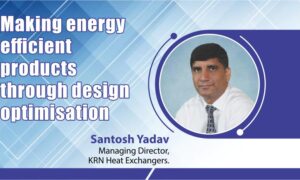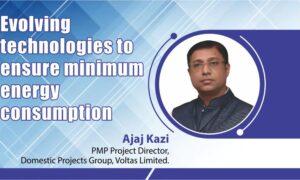All chillers would also need to follow standards codes of either the BEE Star rating program, ASHRAE 90:1 or ECBC.
What are the current market trends for chillers and cooling technologies?
As per the research conducted the energy consumption in any building is as below:
- Ventilation fans 5 percent
- Miscellaneous equipment 16 percent
- Area lighting 22 percent
- Air-conditioning 57 percent
The Air-conditioning equipment here includes the major power guzzlers, like chillers and air handling units in a building just by reducing this 57 percent energy consumption. We can drive towards Greener sustainable buildings and this should be the key focus area while designing and implementing any chiller technologies.
Current market trends witness a complete market shift, considering the year before the pandemic where cooling units, like chillers were largely seen in commercial buildings like – IT/ ITES office spaces, malls, and industries etc. Today, in prevailing Covid situation, since the year 2020 and FY 2021 onwards, the market trend is towards the manufacturing industries like Textile, food, pharma and server room data centres etc., hence there is a dynamic shift of market application and needs for the chillers based cooling.
The Chiller technologies are now trending towards meeting such market application demands. Mentioned below are a few of the chiller trends.
Key chillers market trends
- Variable Frequency Drive (VFD) – A Variable Frequency Drive (VFD) is a system used for controlling the speed of a motor by controlling the frequency of the electrical input. It is an energy-saving device that can save up to 10 percent~15 + of the power consumed by the chiller.
- Magnetic bearing chillers – These are magnetic levitating based technology along with Oil Free with savings of close to 30 percent + over any standard chillers.
- Adiabatic Pads – also known as “Evaporative water cooled pads” which are hooked onto the Heat exchanger to reduce the harsh ambient condition which improves the heat transfer with overall savings of up to 5 percent again depending upon the Delta T between dry bulb and wet bulb temperature.
What new cooling technology opportunities are available to provide space cooling and process cooling solutions?
The cooling technologies have seen major innovation and developments keeping in view of the market demands and trends with the core factor of sustainability, As far as reports conducted India faces water scarcity and fuelling the problem water consumption for anAir-conditioning equipment is 50 percent ~ 60 percent which is primarily used by Water Cooled type Chillers. Such stringent water demands have driven the concern for trends to move towards the selection of compact air cooled chillers or even Hybrid chillers which are a combination of both Air/ Water cooled chillers to save water consumption at site.
For Process Cooling Application Mini Scroll Chillers with VFD drives are used and for Space cooling we see the implementation of high efficient Screw / Centrifugal chillers along with the implementation of “Free Cooling Chillers” as the term suggests chillers provide free chilled water at favourable ambient conditions wherein the chillers bypasses the compressor usage and thereby cools the space and thus savings tons of power consumption during the operational time of the chillers.
Brief Working principle
At low ambient the chillers shall operate at full Free Cooling mode and as the ambient increase further above the set point the compressors starts operation from mixed mode i.e., (Free Cooling + Full Direct Expansion) and then eventually to full Direct Expansion kicks in. The set point temperature is the temperature interrelation of the chilled water supply and ambient; by raising the chilled water temperature the set point temperature can be increased which shall enable maximum Free Cooling or even mixed modes.
The Free cooling is gaining quick momentum as cities like Delhi, Bangalore and other cities have favourable lower ambient temperature to operate Free cooling modes for20 ~30 percent of the time in a year.
For preserving perishable goods mostly, what are various chiller technologies and refrigerants in equipment that are used in super markets?
The Super / Hyper markets require chillers cooling for two of its needs.
- Cooling for Industrial equipment
- Cooling for Space Cooling.
To meet such demands the Chillers further come in two categories of Chilled water Supply Temperature.
- Positive Supply Chilled water
- Negative Supply of Chilled Water.
The positive supply of chilled water is at a range of say 7 Deg C or more which is typically used for Space cooling for maintaining a constant room temperature of 24 Deg C + for both people and the perishable goods .
The negative supply of chilled water is at a range of say (– 5 deg C) which is typically used to feed the industrial equipment which in turn manufactures / processes the perishable goods.
As far the refrigerants are concerned in a positive supply chilled water chiller system the refrigerant used is a HFO – Hydro Fluoro-Olefins a new class of refrigerants that have a much lesser global warming potential than its HFC – Hydro Fluoro carbons, the refrigerants used in a Negative supply chilled water is a combination of HFO + Brine, brine especially to avoid freezing at minus temperatures.
Are rising temperatures that influence global warming driving the demand for cooling equipment more than ever?
Yes for sure, as per reports the global chillers market size is estimated to be USD 4.1 billion in 2021 and is projected to reach USD 4.8 billion by 2026, at a CAGR of 3.0 percent between 2021 and 2026. Of course there are various factors like market expansion of various industry like manufacturing hubs, pharmas, data centres, commercial space etc. However, to add to it the rising temperature also plays vital roles which eventually increase the cooling demands at the site.
However keeping in view of the sustainability goals on the chillers if the Room temperature set point could be increased beyond 24 Deg c + thereby the Chilled water in /out could be also increased from a standard range of 7 / 12 deg C to 10/15 deg c or more which eventually would have a savings of app .. 40 percent + this would be a very useful tip in terms of reducing the power consumption in the rising chillers cooling demands.
All chillers would also need to follow standards codes of either the BEE Star rating program or the ASHRAE 90:1 or ECBC to meet the COP Coefficient of Performance standards and chillers tested in accordance with AHRI 550/590 conditions.
What opinion do you hold towards increasing construction activities in the country that is expected to have a positive impact on the chillers market growth in the country?
As per report, the Indian construction market is expected to grow at a CAGR of approximately 11 percent and with India’s average temperature rise by around 0.7 degrees Celsius the cooling demands like chillers would also exponentially grow.
Do you think chiller manufacturers are also looking into integrating renewable energy systems like thermal hybrid panels?
Since the major power consumption in an HVAC system is chillers it would be interesting to see chillers integrated with thermal panels, but with current limits of technology, such leaps are talk of the future.
Cookie Consent
We use cookies to personalize your experience. By continuing to visit this website you agree to our Terms & Conditions, Privacy Policy and Cookie Policy.















